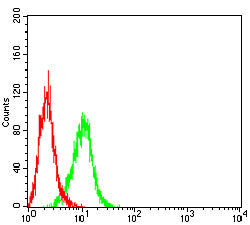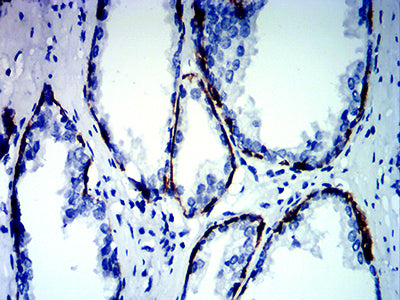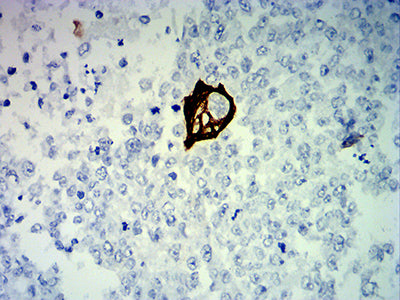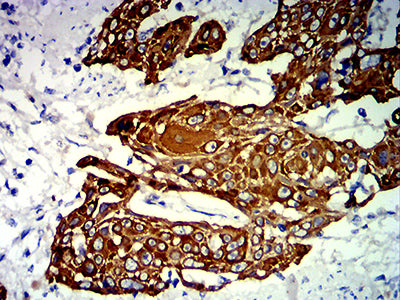





| WB | 1/500 - 1/2000 | Human,Mouse,Rat |
| IF | 咨询技术 | Human,Mouse,Rat |
| IHC | 1/200 - 1/1000 | Human,Mouse,Rat |
| ICC | 技术咨询 | Human,Mouse,Rat |
| FCM | 1/200 - 1/400 | Human,Mouse,Rat |
| Elisa | 1/10000 | Human,Mouse,Rat |
| Aliases | K13; CK13; WSN2 |
| Entrez GeneID | 3860 |
| clone | 7D7A2 |
| WB Predicted band size | 49.5kDa |
| Host/Isotype | Mouse IgG1 |
| Antibody Type | Primary antibody |
| Storage | Store at 4°C short term. Aliquot and store at -20°C long term. Avoid freeze/thaw cycles. |
| Species Reactivity | Human |
| Immunogen | Purified recombinant fragment of human KRT13 (AA: 104-458) expressed in E. Coli. |
| Formulation | Purified antibody in PBS with 0.05% sodium azide |
+ +
以下是关于KRT13抗体的3篇示例文献(内容基于公开研究概括,具体文献需根据实际数据库检索验证):
---
1. **文献名称**: *"KRT13 as a Biomarker for Differentiation in Oral Squamous Cell Carcinoma"*
**作者**: Smith A, et al.
**摘要**: 研究通过免疫组化分析发现,KRT13抗体在正常口腔黏膜中高表达,但在口腔鳞癌组织中显著下调。KRT13的缺失与肿瘤分化程度低和预后不良相关,提示其可能作为口腔癌诊断和分级的潜在标志物。
---
2. **文献名称**: *"Role of Keratin 13 in Esophageal Squamous Cell Carcinoma Progression"*
**作者**: Chandramouleeswaran PM, et al.
**摘要**: 利用KRT13抗体进行Western blot和免疫荧光实验,发现KRT13在食管鳞癌中表达降低,且其表达水平与上皮间质转化(EMT)标志物呈负相关,表明KRT13可能通过抑制EMT过程抑制肿瘤侵袭。
---
3. **文献名称**: *"KRT13 Antibody Validation for Cutaneous Pathology Studies"*
**作者**: Lee JH, et al.
**摘要**: 本文系统验证了KRT13抗体在皮肤组织中的特异性,发现其在毛囊和某些表皮细胞中特异性表达。研究进一步证实KRT13在遗传性皮肤病(如先天性厚甲症)中表达异常,提示其在皮肤屏障功能中的作用。
---
如需具体文献,建议通过PubMed或Google Scholar搜索关键词“KRT13 antibody”“KRT13 expression”或结合研究领域(如癌症、皮肤病等)进一步筛选。
Keratin 13 (KRT13) is a type I intermediate filament protein belonging to the keratin family, which forms structural components of epithelial cell cytoskeletons. Primarily expressed in non-keratinizing stratified squamous epithelia, KRT13 is found in tissues like the oral mucosa, esophagus, cervix, and vaginal lining. It pairs with keratin 4 (KRT4) to maintain epithelial integrity, providing mechanical resilience and regulating cell differentiation.
KRT13 antibodies are vital tools for studying epithelial biology and pathology. They help detect KRT13 expression patterns in normal tissues and diseases, particularly in cancers. Reduced KRT13 levels are associated with squamous cell carcinomas (e.g., oral, esophageal), where its downregulation often correlates with tumor progression and poor differentiation. These antibodies are also used to investigate precancerous lesions (e.g., leukoplakia) and benign disorders (e.g., white sponge nevus caused by KRT13 mutations).
In research, KRT13 antibodies enable techniques like immunohistochemistry, Western blotting, and immunofluorescence to assess tissue-specific localization, protein quantification, and epithelial subtype characterization. Their specificity aids in distinguishing between normal, dysplastic, and malignant tissues, supporting diagnostic and prognostic evaluations in clinical and experimental settings.
×